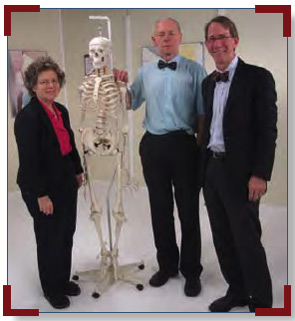
On August 14, 2003, thought leaders in rheumatology and dermatology were set to arrive at the New York Marriott Marquis to start work on a collaborative infrastructure to advance the understanding, diagnosis, and treatment of cutaneous psoriasis (PsC) and psoriatic arthritis (PsA). The meeting was the culmination of nearly two years of work on the part of rheumatology and dermatology leaders, including Oliver FitzGerald, Dafna Gladman, Philip Helliwell, Arthur Kavanaugh, Gerald Krueger, Philip Mease, Chris Ritchlin, and others.
And then, just as attendees were travelling to New York, the second-most widespread electrical blackout in history occurred. Some participants’ flights were cancelled due to the blackout. Those whose flights had lifted off before the outage arrived to find chaos. They combed through piles of luggage and endured long waits for cabs. When they arrived at the Marriott, many had to climb 30 flights of stairs using flashlights.
Undaunted, the meeting organizers searched out a hotel with power and relocated at the Warwick Hotel. By the time he arrived at the Marriott and saw the relocation sign, noted psoriasis researcher Gerald G. Krueger, MD, had walked a mile and a half in 92-degree heat with his luggage in tow. Nevertheless, the next morning, attendees rolled up their sleeves for a full day of presentations on the state of the art in PsA and PsC science. One founder was asked to create an acronym. Recalls Philip Helliwell, MD, PhD, senior lecturer in rheumatology in the Section of Musculoskeletal Disease at the University of Leeds in the United Kingdom, “I wrote the acronym on the back of an envelope!” At the end of the meeting, the group had a name and an acronym: the Group for Research and Assessment of Psoriasis and Psoriatic Arthritis (GRAPPA).
Dafna D. Gladman, MD, professor of medicine at the University of Toronto and senior scientist at Toronto Western Research Institute, in Ontario, Canada, a major driver of the GRAPPA effort and the organization’s first president, says, “It was a great meeting. Because of this power outage, there was more of a camaraderie that might not have developed otherwise.”
The group’s charge was ambitious: to provide an international forum for communication between dermatologists and rheumatologists, industry, and patient service leagues to expedite their research and educational agenda. Founders wasted no time once GRAPPA formed, launching several initiatives to meet their goals. Taking a cue from another group consortium organized around ankylosing spondylitis (called the Assessment of SpondyloArthritis international Society or ASAS; see “A Common Language for Spondyloarthritis” for more on this group), GRAPPA quickly began participation in the Outcome Measures in Rheumatology (OMERACT) process in 2004 to prioritize their domains of inquiry within PsA and PsC research.1

Eight years later, the group continues to grow and holds annual meetings, both standalone and in concert with other rheumatology and dermatology meetings. The recent 2010 meeting in Miami, says Dr. Helliwell, “was probably one of the most vital and electric that I’ve attended.”
Matchless in Medicine
Because psoriatic disease affects multiple systems, says Joel M. Gelfand, MD, MSCE, medical director of the Clinical Studies Unit, assistant professor of dermatology and epidemiology, and senior scholar at the Center for Clinical Epidemiology and Biostatistics at the University of Pennsylvania Health System in Philadelphia, “The best way to solve problems is to bring people together who have expertise in different areas.” What makes the organization unique, he adds, is that it has accomplished a synthesis of evidence-based guidelines for treating psoriatic disease from both the skin and joint perspective and has created an infrastructure for testing a variety of diagnostic tools.
“GRAPPA, working through the OMERACT organization, has allowed us to develop the tools we need to assess patients with PsA,” says Christopher T. Ritchlin, MD, MPH, professor of medicine at the University of Rochester Medical Center in Rochester, N.Y. Dr. Ritchlin is a long-time collaborator with Dr. Gladman.
“Our goals have always been a little bit outlandishly promising,” states Arthur Kavanaugh, MD, professor of medicine and director of the Center for Innovative Therapy in the Division of Rheumatology, Allergy and Immunology at the University of California at San Diego.
Timeline
2003–First face-to-face GRAPPA annual meeting/standalone meeting, held in New York
2004–Prioritized domains of inquiry within PsA and PsC research finalized at OMERACT
2004–Intranet for GRAPPA launched
2006–GRAPPA bylaws and adopted
2006–Development of evidence-based review of PsA treatments published
Everything Came Together
PsA was first described by Verna Wright in the 1960s. A bit later, he and John Moll developed the PsA criteria. After those events, interest in the disease “trickled on for 20 to 30 years,” says Dr. Helliwell. [See “Psoriatic Arthritis: From Leeds to the Limelight” for a history of PsA written by Drs. Helliwell and Ritchlin.] In the late 1990s, Dr. Helliwell and a PhD fellow, Will Taylor, set up the Classification of Psoriatic Arthritis, or CASPAR, study with six European centers, later expanding to include 30 centers worldwide.2 As the study drew to a conclusion, others urged them to continue the collaboration.
In the meantime, Philip J. Mease, MD, director of rheumatology research at Swedish Medical Center and clinical professor at the University of Washington in Seattle, had just finished the first study of etanercept in PsA, showing for the first time progress in reducing inflammation and joint damage.3 More rheumatologists and dermatologists, as a result, became interested in PsA and PsC because they now had more effective treatments to offer their patients. A core group of people began floating the idea of forming a group specific to PsA and PsC. Dr. Mease was instrumental in securing funding to stage the first meeting and an ongoing organization. “I think Philip Mease and Dafna, really, had the idea that we should not stop with collaboration when CASPAR finished; that we should keep the forward push,” recalls Dr. Helliwell. “Everything came together.”
Specialty Cross-Fertilization
Because PsC and PsA are intertwined (between 25%–30% of patients with psoriasis will go on to develop PsA), there was no doubt about involving dermatologists, says Dr. Gladman. Currently, half of the steering and executive committees are dermatologists. “Their numbers are coming up nicely,” she reports.
“I think GRAPPA’s biggest achievement is getting 350 people, including dermatologists, worldwide, as part of this organization,” says Dr. Helliwell. Abrar A. Qureshi, MD, MPH, vice chair of the department of dermatology at Brigham and Women’s Hospital, and assistant professor at Harvard Medical School in Boston, is currently communications lead for GRAPPA’s Identification of PsA committee. He agrees with Dr. Helliwell. “GRAPPA has become a place where rheumatologists and dermatologists can share knowledge about their respective care paradigms in a very open and free environment, without being concerned about competition,” he notes.

“We’re very appreciative of the efforts of GRAPPA,” says Bruce F. Bebo, Jr., PhD, director of research and medical programs at the National Psoriasis Foundation (NPF) in Portland, Ore. “I am particularly excited about their work promoting PsA and PsC registries, as there is a significant unmet need for more information on the natural history of these diseases,” he notes. The NPF is now collecting DNA and clinical information from 2,000 PsC and PsA patients through the Victor Henschel BioBank.
World-renowned psoriasis expert Dr. Krueger, who is professor of dermatology and Benning Presidential Endowed Chair at the University of Utah in Salt Lake City, has been leading the Utah Psoriasis Initiative (UPI) to quantify the phenotypic variants of psoriatic disease in a 1,300-patient cohort. “The ‘elephant in the room’ was psoriatic arthritis,” says Dr. Krueger. “We’ve found with time that PsA is present 24.6% of the time in the UPI. What I’ve learned from this group of investigators is that psoriatic arthritis also has many phenotypic variants, and those have come into much sharper focus as a result of GRAPPA.”
While rheumatologists can help their dermatology colleagues learn to make the diagnosis of PsA in PsC patients, dermatologists can work with their rheumatology colleagues to help manage the nails, scalp, plantar disease, and inverse psoriasis. “The synergy in GRAPPA really enables diagnosis, management, and further research into the etiology of the disease,” says Dr. Qureshi. He has developed a patient self-report questionnaire called Psoriatic Arthritis Screening and Evaluation tool (PASE), which is now showing approximately 93% sensitivity and 82% specificity for identifying inflammatory arthritis in the PsC patient. He has been collaborating with Dr. Enrique Soriano in Buenos Aires, whose data from a small study using the PASE suggest that questionnaire scores correlate with the DAS-28.
Structure Evolves
Early on, says Dr. Gladman, the group’s structure consisted of several key committees—steering, executive, publications, and treatment recommendations—while she and Philip Mease acted as a two-person ad-hoc organizing committee. In 2005, Dr. Helliwell proposed that the group adopt a more formal structure for governance, both to allow more democratic input and to ensure that leadership positions would rotate. He had been involved with several other organizations and drew on that experience to do so. In the first elections, Dr. Gladman was elected president and Philip Mease, MD, became vice president. After three years, Dr. Mease assumed the title of president and Wolf Henning-Boehncke, MD, that of vice president. It’s a healthier configuration, says Dr. Helliwell, which will allow more room for expansion. Dr. Kavanaugh agrees. “You have to have turnover and to have other people involved than just the founders. Otherwise, things don’t evolve. I think GRAPPA has built a good foundation that will support that, and hopefully it’ll exist 20 years from now and even take things in a different direction.”

Vital Expansions
In March, rheumatologists Drs. Chandran, Helliwell, and Mease, and dermatologists Drs. Krueger and Langley traveled to Fortaleza, Brazil, to lead a reliability exercise for the assessment of joints, dactylitis, enthesitis, skin, and nails in psoriasis patients, using some newly minted training videos and direct examination of patients to teach a large group of rheumatologists and dermatologists gathered from many Latin American countries. The effort was organized in conjunction with the Latin American Psoriasis and Psoriatic Arthritis Society (LAPPAS), which will soon launch a prospective study to characterize the phenotype of PsA in Latin American patients. Similar projects in Asia are also forming.
Luis R. Espinoza, MD, chief of the section of rheumatology and professor of medicine at Louisiana State University Health Science Center in New Orleans, a long-time researcher in PsA, is proud of the international outreach efforts. “GRAPPA fosters interrelationship between groups,” he notes, “and it’s really open now. It’s not just an American or a European organization—it is global, an international organization.” He credits Dr. Sergio Toloza, an Argentinian rheumatologist, and Dr. Rafael Valle-Oñate from Bogota, Colombia, who have spearheaded the LAPPAS/GRAPPA partnership in this area.
Missions Accomplished?
Following the publication of several key projects, such as the core set of domains for PsA and international treatment guidelines for psoriatic arthritis, the group has several concurrent projects.4,5 Oliver FitzGerald, MD, Newman Clinical Research Professor in the School of Medicine and Medical Science at St. Vincent’s University Hospital in Dublin, Ireland, and Dr. Helliwell are lead investigators on one of the largest, the GRACE project. Data have now been collected on 450 PsA patients, and the group is working closely with OMERACT to develop composite measures of disease activity and response to therapy, accounting for the complex interplay of musculoskeletal and skin elements of PsA and PsC. With new drugs surfacing every year, says Dr. Helliwell, “they are going to have to be evaluated, and our organization is leading the evaluation and outcomes science in PsA.” Plans are also in the works for a multicenter study that will focus on identifying markers that predict which patients are going to do poorly based on X-ray indicators, according to Dr. FitzGerald.

Dr. Ritchlin has been working with Dr. Gladman and J.T. Elder on a 4,000-patient clinical registry currently funded through the Canadian Institutes of Health Research. The hope is to secure additional funding to link the registry to the entire GRAPPA organization.
GRAPPA leaders admit that challenges remain for their organization. Funding will continue to be an issue going forward, says Dr. Gladman, as they seek to expand the clinical registries. Encouraging more dermatologists to actively lead GRAPPA projects is also key, says Dr. Gelfand. Dr. Qureshi believes GRAPPA’s challenge is “to promote clinical, basic science, and translational research that is on the fringes of dermatology and rheumatology, because that is its strength.” Dr. FitzGerald says, “The challenge will be to maintain the momentum and to make sure there are others who will take the mantle on and continue the good work.”
“What you’ve got here is an amazing success story,” concludes Dr. Gladman. Not only does GRAPPA combine two specialties, but its reach is international, she emphasizes. “When we develop our projects and our programs for the meetings, we’re very sensitive about making sure there’s participation from everywhere.” Development of the treatment guidelines was a case in point. In some countries, even methotrexate is not available, so the guidelines had to be “something that would hold internationally,” she notes.
Dr. Mease is gratified by the growing participation of dermatology residents, as well as rheumatology fellows in the trainee sessions at each of the meetings. An example is his partnering with Michael Krathen, a dermatology resident at Tufts University in Boston, and Alice Gottlieb, a dually boarded dermatologist and rheumatologist who is chair of dermatology at Tufts University School of Medicine, on a comprehensive literature review of the prevalence of skin cancer in autoimmune disease patients, including those with rheumatoid arthritis, PsA, and PsC. They are now pursuing this line of work further by exploring the database of the Consortium of Rheumatology Researchers of North America to better characterize the prevalence of skin malignancies in patients with RA and PsA and the relationship to treatment. “This was a virtual relationship between myself in Seattle and a dermatology resident and his mentor at Tufts. Without an organization like GRAPPA, none of that would have occurred.”
Online Resource
A compendium of publications generated by GRAPPA members is available online at www.grappanetwork.org/resources_pub.php.
Like many of his colleagues, Dr. Ritchlin has found his association with GRAPPA to be a “very productive experience.” He says enthusiastically, “It sort of formed on the back of a napkin one day and managed to blossom into something pretty incredible that none of us would have anticipated.”
References
- Gladman DD, Strand V, Mease PJ, et al. OMERACT 7 psoriatic arthritis workshop: Synopsis. Ann Rheum Dis.2005;64:ii115-116.
- Taylor WJ, Helliwell PS. Development of diagnostic criteria for psoriatic arthritis: Methods and process. Curr Rheumatol Rep. 2004;6:299-305.
- Mease PJ, Goffe BS, Metz J, et al. Etanercept in the treatment of psoriatic arthritis and psoriasis: A randomized trial. Lancet. 2000;356:385-390.
- Gladman DD, Mease PJ, Strand V, et al. Consensus on a core set of domains for psoriatic arthritis. J Rheumatol. 2007;34:1167-1170.
- Kavanaugh AF, Ritchlin CT, GRAPPA Treatment Guideline Committee. Systematic review of treatments for psoriatic arthritis: An evidence based approach and basis for treatment guidelines. J Rheumatol. 2006;33:1417-1421.


